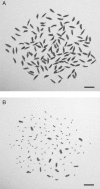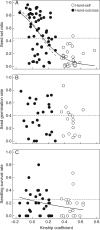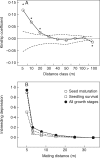Kinship between parents reduces offspring fitness in a natural population of Rhododendron brachycarpum
- PMID: 20202970
- PMCID: PMC2850802
- DOI: 10.1093/aob/mcq018
Kinship between parents reduces offspring fitness in a natural population of Rhododendron brachycarpum
Abstract
Background and aims: A reduction in offspring fitness resulting from mating between neighbours is interpreted as biparental inbreeding depression. However, little is known about the relationship between the parents' genetic relatedness and biparental inbreeding depression in their progeny in natural populations. This study assesses the effect of kinship between parents on the fitness of their progeny and the extent of spatial genetic structure in a natural population of Rhododendron brachycarpum.
Methods: Kinship coefficients between 11,858 pairs of plants among a natural population of 154 R. brachycarpum plants were estimated a priori using six microsatellite markers. Plants were genotyped, and pairs were selected from among 60 plants to vary the kinship from full-sib to unrelated. After a hand-pollination experiment among the 60 plants, offspring fitness was measured at the stages of seed maturation (i.e. ripening) under natural conditions, and seed germination and seedling survival under greenhouse conditions. In addition, spatial autocorrelation was used to assess the population's genetic structure.
Key results: Offspring fitness decreased significantly with increasing kinship between parents. However, the magnitude and timing of this effect differed among the life-cycle stages. Measures of inbreeding depression were 0.891 at seed maturation, 0.122 (but not significant) at seed germination and 0.506 at seedling survival. The local population spatial structure was significant, and the physical distance between parents mediated the level of inbreeding between them.
Conclusions: The level of inbreeding between individuals determines offspring fitness in R. brachycarpum, especially during seed maturation. Genetic relatedness between parents caused inbreeding depression in their progeny. Therefore, biparental inbreeding contributes little to reproduction and instead acts as a selection force that promotes outcrossing, as offspring of more distant (less related) parents survive better.
Figures




References
-
- Akaike H. A new look at the statistical model identification. IEES Transactions on Automatic Control. 1974;19:716–723.
-
- Armstrong DP, Cassey P. Estimating the effect of inbreeding on survival. Animal Conservation. 2007;10:487–492.
-
- Bacles CFE, Burczyk J, Lowe AJ, Ennos RA. Historical and contemporary mating patterns in remnant populations of the forest tree Fraxinus excelsior L. Evolution. 2005;59:979–990. - PubMed
-
- Byers DL. Effect of cross proximity on progeny fitness in a rare and a common species of Eupatorium (Asteraceae) American Journal of Botany. 1998;85:644–653. - PubMed
-
- Campbell DR. Comparing pollen dispersal and gene flow in a natural population. Evolution. 1991;45:1965–1968. - PubMed

